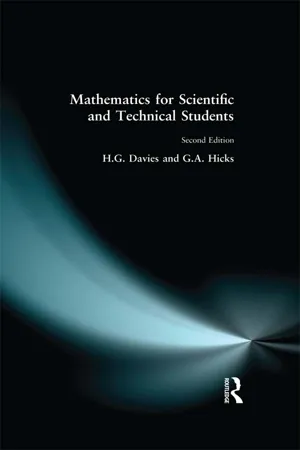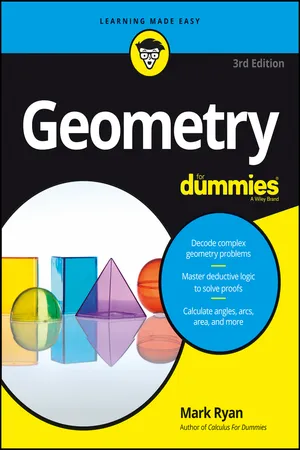Mathematics
Triangle Rules
The Triangle Rules in mathematics refer to the set of rules and properties that govern the relationships between the sides and angles of a triangle. These rules include the Pythagorean theorem, the laws of sines and cosines, and the properties of similar triangles. Understanding and applying these rules is essential for solving problems involving triangles in geometry and trigonometry.
Written by Perlego with AI-assistance
Related key terms
4 Key excerpts on "Triangle Rules"
- H. Davies, H.G. Davies, G.A. Hicks(Authors)
- 2014(Publication Date)
- Routledge(Publisher)
Chapter 3Trigonometry
3.1 Introduction
Trigonometry is the branch of Mathematics that deals with the relationships between the sides and the angles of a triangle. Provided that a minimum of
are known about any triangle, the other unknown sides or angles can be calculated using trigonometrical methods.(i) 3 sides, (ii) 2 sides and 1 angle or (iii) 1 side and 2 angles Trigonometry is based on the trigonometrical ratios of sine, cosine and tangent, which are the ratios between the sides of a right-angled triangle. The values of these ratios depend upon the size of the angles, and do not depend on the size of the triangle.3.2 Trigonometric ratios
In Fig. 3.1 sides are given names with respect to the angle θ. The side opposite the right-angle (90°) is called the hypotenuse. The other two sides are named according to their position relative to the angle. The ratios are defined asFor a known angle the values of these ratios can be obtained from an electronic calculator. For example sin 40°=0.6428 can be obtained by entering 40 and pressing the sin key.Fig. 3.1Example 3.1 Find the lengths of the unknown sides in the steel bracket ABC shown in Fig 3.2 .Fig. 3.2Using with θ = 60° andMultiply both sides by 21.4:Using again with θ = 60° and h = 21.4cmExample 3.2 Fig 3.3 shows a voltage diagram for an electronic circuit. Calculate the phase angle ϕ between the two voltages.Fig. 3.3Note: ϕ = cos-1 0.5965 means that ϕ is an angle which has a cos of 0.5965. The value of ϕ can be obtained from the calculator by entering 0.5965 and pressing thecos−1key. cos-1 is the inverse of the cosine (see Section 3.15 ).3.3 Theorem of Pythagoras
This is an important theorem and is a useful alternative method of finding the third side of a right-angled triangle when the other two sides are known. In the right-angled triangle in Fig 3.4 the sides are labelled a, b, c according to the angles that they are opposite.Fig. 3.4- Alan Sultan, Alice F. Artzt(Authors)
- 2017(Publication Date)
- Routledge(Publisher)
Chapter 5The Triangle: Its Study and Consequences5.1 IntroductionIf you ask adults what theorem they remember from their study of mathematics, they will most probably say, the Pythagorean Theorem. Why should this theorem, usually studied in secondary school, make such a lasting impression? As will be demonstrated in this chapter, this one theorem concerning the relationship of the sides of a right triangle can be extended to the study of (a) all types of triangles, (b) relationships concerning circles, (c) key trigonometric relationships, and (d) concepts of area. It is really quite amazing!To begin, we need only remember a few basic definitions: In a right triangle with acute angle, A ,
Also, we easily see thatsin A =,length of side opposite Alength of hypotenusecos A =,length of side adjacent to Alength of hypotenusetan A =.length of side opposite to Alength of side adjacent to Atan A =.sin Acos AWe begin by discussing how the Pythagorean Theorem can be extended to generate the Law of Cosines and then follow it with the study of the Law of Sines. What is different about this chapter is that these will then be used to prove all the congruence laws, all the main similarity laws, facts about circles, and a host of other relationships in triangles. While people normally think that trigonometry follows geometry, we have demonstrated that we can do things in reverse by showing how the theorems of geometry can be derived from theorems in trigonometry.We will use the following notational conventions throughout: When we say that ∡A = ∡B , we mean that the measures of the two angles are equal. An alternate way of saying this is that ∡A is congruent to ∡B. AB will represent the length ofWhen we say that AB = CD we are saying that the measures ofA B¯andA B¯are equal, or equivalently, that AB is congruent to CD .C D¯5.2 The Law of Cosines and Surprising ConsequencesLaunchDraw a large triangle on a clean sheet of paper. Then measure the length of each of the sides of the triangle you have drawn. Using these same three lengths, try to draw another triangle that is NOT congruent to the first one you drew. Could you do it? Why or why not?- eBook - ePub
- (Author)
- 2008(Publication Date)
- Trade Paper Press(Publisher)
Trigonometry solves problems relating to plane and spherical triangles. Its principles are based on the fixed proportions of sides for a particular angle in a right-angled triangle, the simplest of which are known as the sine, cosine, and tangent (so-called trigonometrical ratios). Trigonometry is of practical importance in navigation, surveying, and simple harmonic motion in physics.trigonometry At its simplest level, trigonometry deals with the relationships between the sides and angles of triangles. Unknown angles or lengths are calculated by using trigonometrical ratios such as sine, cosine, and tangent.Using trigonometry, it is possible to calculate the lengths of the sides and the sizes of the angles of a right-angled triangle as long as one angle and the length of one side are known, or the lengths of two sides. The longest side, which is always opposite to the right angle, is called the hypotenuse . The other sides are named depending on their position relating to the angle that is to be found or used: the side opposite this angle is always termed opposite and that adjacent is the adjacent . So the following trigonometrical ratios are used:sine
The sine is the function of an angle in a right-angled triangle which is defined as the ratio of the length of the side opposite the angle to the length of the hypotenuse (the longest side). It is usually shortened to sin .sine The sine is a function of an angle in a right-angled triangle found by dividing the length of the side opposite the angle by the length of the hypotenuse (the longest side). Sine (usually abbreviated sin) is one of the fundamental trigonometric ratios.Various properties in physics vary sinusoidally; that is, they can be represented diagrammatically by a sine wave (a graph obtained by plotting values of angles against the values of their sines). Examples include simple harmonic motion, such as the way alternating current (AC) electricity varies with time.sine (left) The sine of an angle; (right) constructing a sine wave. The sine of an angle is a function used in the mathematical study of the triangle. If the sine of angle β is known, then the hypotenuse can be found given the length of the opposite side, or the opposite side can be found from the hypotenuse. Within a circle of unit radius (left), the height P1 ,A1 equals the sine of angle P1 0A1 - eBook - ePub
- Mark Ryan(Author)
- 2016(Publication Date)
- For Dummies(Publisher)
Good point. The Pythagorean Theorem is easier for some triangles (especially if you’re allowed to use your calculator). But — take my word for it — this triple triangle technique can come in handy. Take your pick. Getting to Know Two Special Right Triangles Make sure you know the two right triangles in this section: the triangle and the triangle. They come up in many, many geometry problems, not to mention their frequent appearance in trigonometry, pre-calculus, and calculus. Despite the pesky irrational (square-root) lengths they have for some of their sides, they’re both more basic and more important than the Pythagorean triple triangles I discuss earlier. They’re more basic because they’re the progeny of the square and equilateral triangle, and they’re more important because their angles are nice fractions of a right angle. The 45°- 45°- 90° triangle — half a square The triangle (or isosceles right triangle): The triangle is a triangle with angles of,, and and sides in the ratio of. Note that it’s the shape of half a square, cut along the square’s diagonal, and that it’s also an isosceles triangle (both legs have the same length). See Figure 8-7. © John Wiley & Sons, Inc. FIGURE 8-7: The triangle. Try a couple of problems. Find the lengths of the unknown sides in triangles BAT and BOY shown in Figure 8-8. © John Wiley & Sons, Inc. FIGURE 8-8: Find the missing lengths. You can solve triangle problems in two ways: the formal book method and the street-smart method. Try ’em both and take your pick. The formal method uses the ratio of the sides from Figure 8-7. For, because one of the legs is 8, the x in the ratio is 8
Learn about this page
Index pages curate the most relevant extracts from our library of academic textbooks. They’ve been created using an in-house natural language model (NLM), each adding context and meaning to key research topics.



